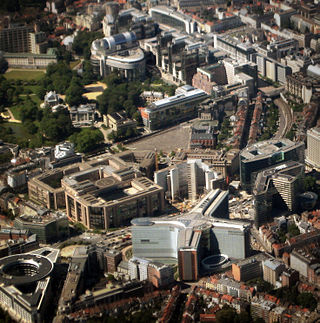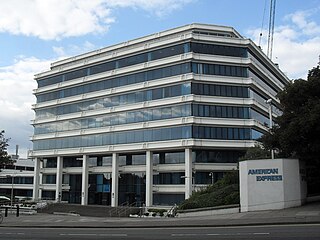
Charles-Édouard Jeanneret, known as Le Corbusier, was a Swiss-French architect, designer, painter, urban planner, writer, and one of the pioneers of what is now regarded as modern architecture. He was born in Switzerland and became a French citizen in 1930. His career spanned five decades, and he designed buildings in Europe, Japan, India, and North and South America.

Les Halles was Paris' central fresh food market. It last operated on January 12, 1973, after which it was "left to the demolition men who will knock down the last three of the eight iron-and-glass pavilions" and replaced by an underground shopping centre. The hugely unsuccessful and unpopular 1960s modern development together with the unattractive 1980s modern garden on top of it, was demolished yet again in 2010, and replaced by the Westfield Forum des Halles, a modern shopping mall built largely underground and directly connected to the massive RER and métro transit hub of Châtelet–Les Halles. The shopping mall welcomes 150,000 visitors daily.

Urban renewal is a program of land redevelopment often used to address urban decay in cities. Urban renewal involves the clearing out of blighted areas in inner cities to clear out slums and create opportunities for higher class housing, businesses, and other developments.

Lúcio Marçal Ferreira Ribeiro Lima Costa was a Brazilian architect and urban planner, best known for his plan for Brasília.

Although Birmingham in England has existed as a settlement for over a thousand years, today's city is overwhelmingly a product of the 18th, 19th, and 20th centuries, with little surviving from its early history. As it has expanded, it has acquired a variety of architectural styles. Buildings of most modern architectural styles in the United Kingdom are located in Birmingham. In recent years, Birmingham was one of the first cities to exhibit the blobitecture style with the construction of the Selfridges store at the Bullring Shopping Centre.

The Palace of Justice of Brussels or Law Courts of Brussels is a courthouse in Brussels, Belgium. It is the country's most important court building, seat of the judicial arrondissement of Brussels, as well as of several courts and tribunals, including the Court of Cassation, the Court of Assizes, the Court of Appeal of Brussels, the Tribunal of First Instance of Brussels, and the Bar Association of Brussels.

Brussels Central Station, officially Brussels-Central, is a railway and metro station in central Brussels, Belgium. It is the second busiest railway station in Belgium and one of three principal railway stations in Brussels, together with Brussels-South and Brussels-North. First completed in 1952 after protracted delays caused by economic difficulties and World War II, it is the newest of Brussels' main rail hubs.

The White City is a collection of over 4,000 buildings in Tel Aviv from the 1930s built in a unique form of the International Style, commonly known as Bauhaus, by Jewish architects who fled to the British Mandate of Palestine from Germany after the rise to power of the Nazis. Tel Aviv has the largest number of buildings in the Bauhaus/International Style of any city in the world. Preservation, documentation, and exhibitions have brought attention to Tel Aviv's collection of 1930s architecture. In 2003, the United Nations Educational, Scientific and Cultural Organization (UNESCO) proclaimed Tel Aviv's White City a World Cultural Heritage site, as "an outstanding example of new town planning and architecture in the early 20th century." The citation recognized the unique adaptation of modern international architectural trends to the cultural, climatic, and local traditions of the city. Bauhaus Center Tel Aviv organizes regular architectural tours of the city.

Fes el Bali is the oldest walled part of Fez, Morocco. Fes el Bali was founded as the capital of the Idrisid dynasty between 789 and 808 AD. UNESCO listed Fes el Bali, along with Fes Jdid, as a World Heritage Site in 1981 under the name Medina of Fez. The World Heritage Site includes Fes el Bali's urban fabric and walls as well as a buffer zone outside of the walls that is intended to preserve the visual integrity of the location. Fes el Bali is, along with Fes Jdid and the French-created Ville Nouvelle or “New Town”, one of the three main districts in Fez.
Frank Moulaert is Professor of Spatial Planning at the Department of Architecture, Urban Design and Regional Planning at Catholic University of Leuven. He is Director of the Urban and Regional Planning Research Group and chairs the Leuven Space and Society Research Centre at the University. He is also a Visiting Professor at the School of Architecture, Planning and Landscape, Newcastle University.

The Marolles or Marollen is a popular historic neighbourhood of downtown Brussels, Belgium, situated between the Palace of Justice to its south-east, the Chapel Church to its north and the Halle Gate to its south. Its inhabitants are called Marolliens.
Sir Herbert John Baptista Manzoni CBE MICE was a British civil engineer known for holding the position of City Engineer and Surveyor of Birmingham from 1935 until 1963. This position put him in charge of all municipal works and his influence on the city, especially following World War II, completely changed the image of Birmingham.

The Leopold Quarter is a quarter of Brussels, Belgium. Today, the term is sometimes confused with the European Quarter, as the area has come to be dominated by the institutions of the European Union (EU) and organisations dealing with them, although the two terms are not in fact the same, with the Leopold Quarter being a smaller more specific district of the municipalities of the City of Brussels, Etterbeek, Ixelles and Saint-Josse-ten-Noode.
Henri Prost was a French architect and urban planner. He was noted in particularly for his work in Morocco and Turkey, where he created a number of comprehensive city plans for Casablanca, Fes, Marrakesh, Meknes, Rabat, and Istanbul, including transportation infrastructure and avenues with buildings, plazas, squares, promenades and parks.
The Pei Plan was an urban redevelopment initiative designed for downtown Oklahoma City, Oklahoma, United States, in the 1960s and 1970s. It is the informal name for two related commissions of noted architect and urban planner I. M. Pei — namely the Central Business District General Neighborhood Renewal Plan and the Central Business District Project I-A Development Plan. It was formally adopted in 1965, and implemented in public and private phases throughout the 1960s and 1970s.
Heritage Montreal is a Canadian non-profit organization dedicated to protecting the architectural, historic, natural, and cultural heritage of Greater Montreal. Architect Phyllis Lambert founded Heritage Montreal in 1975. It was preceded by Save Montreal, a volunteer group co-founded by Michael Fish after the controversial demolition of the Van Horne Mansion by developer David Azrieli in 1973. Heritage Montreal played a key role in efforts to halt demolition and redevelopment in the McGill Ghetto, also known as Milton Park.

Amex House, popularly nicknamed The Wedding Cake, was the former European headquarters of American Express, a multinational financial services company. Its site is located in the Carlton Hill area of Brighton, part of the English city of Brighton and Hove. The nine-floor building, designed by British architecture firm Gollins, Melvin, Ward & Partners, was commissioned by the company in 1977 to consolidate their operations in Brighton, which had been spread over several sites. The white and blue structure, a landmark on the city skyline, received both praise and criticism for its distinctive style.

A distinctive type of Ottoman tower houses developed and were built in the Balkans, as well as in Oltenia, in Romania, after the Ottoman conquest in the Middle Ages by both Christian and Muslim communities. The practice began during the decline of Ottoman power in the 17th century and flourished until the early 20th century. The tower houses were typically made out of stone, rose three or four storeys, and were square or rectangular in shape. They served both military and civilian (residential) purposes in order to protect the extended family.

The Art Deco movement of architecture and design appeared in Brussels, Belgium, immediately after World War I when the famed architect Victor Horta began designing the Centre for Fine Arts, and continued until the beginning of World War II in 1939. It took its name from the International Exposition of Modern Decorative and Industrial Arts held in Paris in 1925. At the end of World War II, Art Deco in Brussels faded to make way for the modernist and international architectural styles that would mark the postwar period.

The Central Boulevards are a series of grand boulevards in central Brussels, Belgium. They were constructed following the covering of the river Senne (1867–1871), as part of the major urban works by the architect Léon Suys under the tenure of the city's then-mayor, Jules Anspach. They are from south to north and from west to east: the Boulevard Maurice Lemonnier/Maurice Lemonnierlaan, the Boulevard Anspach/Anspachlaan, the Boulevard Adolphe Max/Adolphe Maxlaan, and the Boulevard Émile Jacqmain/Émile Jacqmainlaan.

















